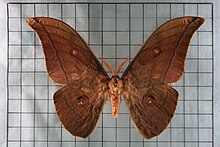Antheraea yamamai: Difference between revisions
m italic title |
|||
| Line 49: | Line 49: | ||
==External links== |
==External links== |
||
*[http://www.lepidoptera.eu/show.php?ID=4976&country=IT European Butterflies and Moths] |
|||
| ⚫ | |||
*[http://www.faunaeur.org/full_results.php?id=295244 Fauna Europaea: Taxonomy] |
*[http://www.faunaeur.org/full_results.php?id=295244 Fauna Europaea: Taxonomy] |
||
| ⚫ | |||
*[http://tpittaway.tripod.com/silk/a_yam.htm |
*[http://tpittaway.tripod.com/silk/a_yam.htm Saturniidae of the Western Palaearctic] |
||
{{Commons category|Antheraea yamamai}} |
{{Commons category|Antheraea yamamai}} |
||
{{wikispecies}} |
{{wikispecies}} |
||
Revision as of 21:34, 13 June 2014
| Antheraea yamamai | |
|---|---|

| |
| Living adult | |

| |
| Antheraea yamamai superba | |
| Scientific classification | |
| Kingdom: | |
| Phylum: | |
| Class: | |
| Order: | |
| Family: | |
| Tribe: | |
| Genus: | |
| Species: | A. yamamai
|
| Binomial name | |
| Antheraea yamamai | |
| Synonyms | |
| |
The Japanese Silk Moth or Japanese Oak Silkmoth (Antheraea yamamai, Japanese: Yamamayu(ga) (山繭(蛾)・ヤママユ(ガ))) is a moth of the Saturniidae family. It is endemic to Japan, but has been imported to Europe for silk production and is now found in South-Eastern Europe, mainly in Austria, North-Eastern Italy and the Balkan. It seems to be spreading north and a population near Deggendorf and Passau (Bayern) has been reported.[1] It has been hybridized artificially with Antheraea polyphemus of North America.[2]




The tensan (天蚕) silk moth (Antheraea yamamai) has been cultivated in Japan for more than 1000 years. It produces a naturally white silk but does not dye well, though it is very strong and elastic. It is now very rare and expensive.[3]
The wingspan is 110–150 mm. Adults are on wing from August to September in one generation depending on the location.
The larva mainly feed on Quercus species, but have also been reported on Fagus sylvatica, Castanea sativa, Carpinus, Rosa and Crataegus.
Subspecies
- Antheraea yamamai yamamai
- Antheraea yamamai bergmani Bryk, 1949
- Antheraea yamamai titan Mell, 1958
- Antheraea yamamai ussuriensis Schachbazov, 1953
- Antheraea yamamai superba Inoue, 1964 (Taiwan)
References
- ^ "Deggendorf and Passau report" (PDF). Retrieved 2011-10-18.
- ^ See Antheraea polyphemus, Gary Botting
- ^ Information sheet from United Nations FAO
External links
- European Butterflies and Moths
- Fauna Europaea: Taxonomy
- Lepiforum.de
- Saturniidae of the Western Palaearctic
